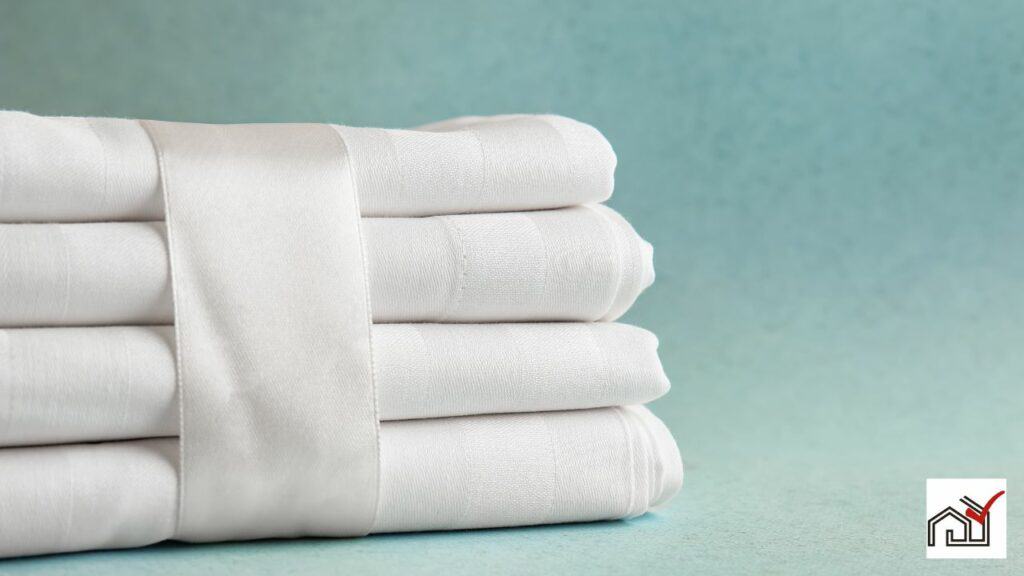In bedding, flat sheets and fitted sheets have different purposes.
A flat sheet, or top sheet, is a plain rectangular cloth that goes between the person sleeping and the blanket. It serves for looks and cleanliness.
A fitted sheet has elastic corners to fit tightly over a mattress, preventing wrinkles.
Flat sheets add an extra layer for comfort and hygiene, while fitted sheets create a smooth and secure sleeping surface.
The choice between them depends on personal preference for convenience, comfort, and bed appearance.
Understanding Flat Sheets
Some people use a flat sheet on top of a fitted sheet for added comfort and hygiene. The fitted sheet fits tightly around the mattress, while the flat sheet acts as a barrier between the person and their duvet or comforter. This can provide extra warmth and a sense of being tucked in. Flat sheets are also easier to clean than bulkier bedding, allowing for a cleaner bed with less frequent washing of heavier items.
A flat sheet can sometimes be used as a substitute for a fitted sheet if it is the right size and shape to tuck under the mattress, demonstrating its functional versatility. On the other hand, some individuals may choose not to use a flat sheet to avoid the additional layer, which can be seen as unnecessary or bothersome, particularly in hot weather.
Benefits of Fitted Sheets
Fitted sheets offer several benefits. They stay in place due to their elastic corners, providing a smooth surface that doesn't bunch up, which helps sleepers rest without interruption. These sheets also protect the mattress from spills, stains, and reduce the likelihood of dust and allergens penetrating the mattress, which is important for those with allergies.
Often made from organic cotton, fitted sheets are hypoallergenic and durable. They are designed to fit various mattress depths, making them suitable for different bed sizes.
In essence, fitted sheets are practical, comfortable, and a key part of bedding.
Key Differences Explained
Fitted sheets have elastic edges and are shaped to fit tightly over a mattress. This design keeps them in place during sleep. Over time, the elastic can wear out, reducing the sheet's ability to stay put.
Flat sheets, on the other hand, are simple rectangles that lie on top of the person in bed and can be tucked in or hang loosely.
The fitted sheet protects the mattress from dirt and body oils, while the flat sheet acts as a barrier between the person and their blankets or duvet cover. This can reduce the need for frequent washing of the heavier bedding.
When buying sheets, it's important to choose the correct size for fitted sheets to ensure a good fit on the mattress. Flat sheets are less size-specific but need to be folded properly for storage.
Both types of sheets are used together for comfort and bed protection.
The Versatility of Flat Sheets
Flat sheets are versatile bedding items that can be used for more than just covering a bed. They are rectangular in shape, which allows for multiple uses. A flat sheet can act as a top sheet to help regulate temperature for those who may sweat during the night or require an additional layer for warmth.
These sheets can also be tucked under the mattress, mimicking the tight fit of a fitted sheet when necessary. Their ample size means they usually stay in place better than smaller sheets.
Beyond their role in bedding, flat sheets can be folded for extra warmth or to protect a duvet cover from wear and tear. Their design makes them easy to store and suitable for various bed-making styles, demonstrating their utility beyond a basic bedding item.
Maintenance and Care Tips
Maintaining and caring for flat and fitted sheets is essential to prolong their use and promote cleanliness. It is important to wash sheets regularly, with a recommended frequency of once every one to two weeks to reduce allergens. When washing, pay attention to the fabric type. For instance, organic cotton sheets can be durable and stay soft, and they are also eco-friendly.
Fitted sheets are designed with elastic edges that make them easy to wash, but they should be handled with care to avoid damaging the elastic. Hot water can be effective in cleaning and removing mites, but always check the care instructions, especially for sheets with special features like temperature control.
Flat sheets are flexible in their use and maintenance. They can be washed without difficulty and can serve as top sheets or even as a replacement for a fitted sheet using hospital corners. They also help keep duvet covers clean by acting as a barrier against body oils and sweat, which can reduce the need to wash heavier bedding frequently.
Taking care of your bedding includes measures beyond washing. Using a mattress protector can prevent damage from spills and stains. Storing sheets in a closed container can keep them free from dust and odors. Making the bed daily helps maintain the positioning of sheets and keeps the sleeping area tidy.
Choosing Your Ideal Bedding
Choosing the right bedding requires considering the benefits of flat versus fitted sheets. Fitted sheets fit tightly on the mattress, prevent slipping, and make the bed look tidy with little effort.
Flat sheets, used as a top layer, add a barrier between you and the duvet cover, offering a layered look and extra warmth.
Consider the advantages and drawbacks of each sheet type. Fitted sheets are easy to put on and tend to stay in place, reducing the need to retuck, but can be harder to fold and store.
Flat sheets are versatile and can act as a fitted sheet when tucked under the mattress. They also protect the duvet cover, potentially decreasing the frequency of washes.
When buying sheets, consider the material. Organic cotton sheets are long-lasting, hypoallergenic, and support eco-friendly practices. They contribute to a clean sleep environment.
Change your sheets regularly for hygiene and improved sleep quality.
Sheet Storage Solutions
Effective sheet storage is essential for maintaining the quality and cleanliness of both flat and fitted sheets. Proper storage extends their life and keeps them hygienic, as sheets are a fundamental aspect of our sleep comfort.
Store your sheets in a closed container to protect them from dust and maintain freshness. This is particularly crucial for fitted sheets with elastic corners that are prone to dust accumulation.
Before storing sheets, wash and dry them completely to prevent mildew, especially in humid environments where a dehumidifier may be necessary. If you have enough closet space, organize your sheets in a way that keeps sets together, such as folding flat sheets and placing them inside their matching duvet cover.
Ensure you have sufficient space for your bedding to avoid over-compression, which can cause wrinkles and mustiness.




